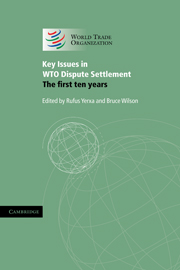Book contents
- Frontmatter
- Contents
- Notes on contributors
- Preface
- Table of cases
- Abbreviations
- PART I Introduction and General Considerations
- PART II The WTO Dispute Settlement System: Its Processes and Its Institutions
- PART III The WTO Dispute Settlement System: Systemic and Other Issues
- 12 The role of lawyers in the WTO dispute settlement system
- 13 Jurisdiction in WTO dispute settlement
- 14 Due process in WTO disputes
- 15 Standards of review in WTO panel proceedings
- 16 Administration of evidence in WTO dispute settlement proceedings
- 17 Confidentiality issues under the DSU: fact-finding process versus confidentiality
- 18 Panels' consultations with scientific experts
- 19 Amicus curiae participation in WTO dispute settlement: reflections on the past decade
- 20 Suspension of concessions and retaliation under the Agreement on Safeguards: the recent US – Steel Safeguards case
- 21 Compliance with WTO dispute settlement decisions: is there a crisis?
- 22 DSU review: a view from the inside
- PART IV Annexes
22 - DSU review: a view from the inside
from PART III - The WTO Dispute Settlement System: Systemic and Other Issues
Published online by Cambridge University Press: 04 August 2010
- Frontmatter
- Contents
- Notes on contributors
- Preface
- Table of cases
- Abbreviations
- PART I Introduction and General Considerations
- PART II The WTO Dispute Settlement System: Its Processes and Its Institutions
- PART III The WTO Dispute Settlement System: Systemic and Other Issues
- 12 The role of lawyers in the WTO dispute settlement system
- 13 Jurisdiction in WTO dispute settlement
- 14 Due process in WTO disputes
- 15 Standards of review in WTO panel proceedings
- 16 Administration of evidence in WTO dispute settlement proceedings
- 17 Confidentiality issues under the DSU: fact-finding process versus confidentiality
- 18 Panels' consultations with scientific experts
- 19 Amicus curiae participation in WTO dispute settlement: reflections on the past decade
- 20 Suspension of concessions and retaliation under the Agreement on Safeguards: the recent US – Steel Safeguards case
- 21 Compliance with WTO dispute settlement decisions: is there a crisis?
- 22 DSU review: a view from the inside
- PART IV Annexes
Summary
The origins of the DSU
From the 1950s through to the 1970s the process for settling disputes under the GATT was ‘wrapped in layers of diplomatic vagueness and indirection’. What has been characterized as a ‘diplomat's jurisprudence’ emerged and was directed at promoting negotiated outcomes to trade disputes.
The story since the end of the 1970s has been one of a disputes system in evolution from this ‘diplomatic’ model, where the emphasis was on facilitating a negotiated outcome, to a more ‘judicial’ model. A decisive step in this evolution was taken during the Uruguay Round.
At the launch of the Uruguay Round in 1986 there was a general recognition that the GATT system for settling disputes needed strengthening. Although the system had worked well in its earlier years, during the 1980s problems began to emerge. As a lead negotiator for the United States during the Uruguay Round has noted, by the end of the 1980s ‘the United States’ frustration with the lack of progress in settling agricultural trade disputes … had led to increased threats by the United States Trade Representative (USTR) to take unilateral trade action under Section 301 of the Trade Act of 1974’. The response of the international community was to work towards developing a more robust and expedited multilateral disputes procedure.
- Type
- Chapter
- Information
- Key Issues in WTO Dispute SettlementThe First Ten Years, pp. 251 - 268Publisher: Cambridge University PressPrint publication year: 2005
- 1
- Cited by



